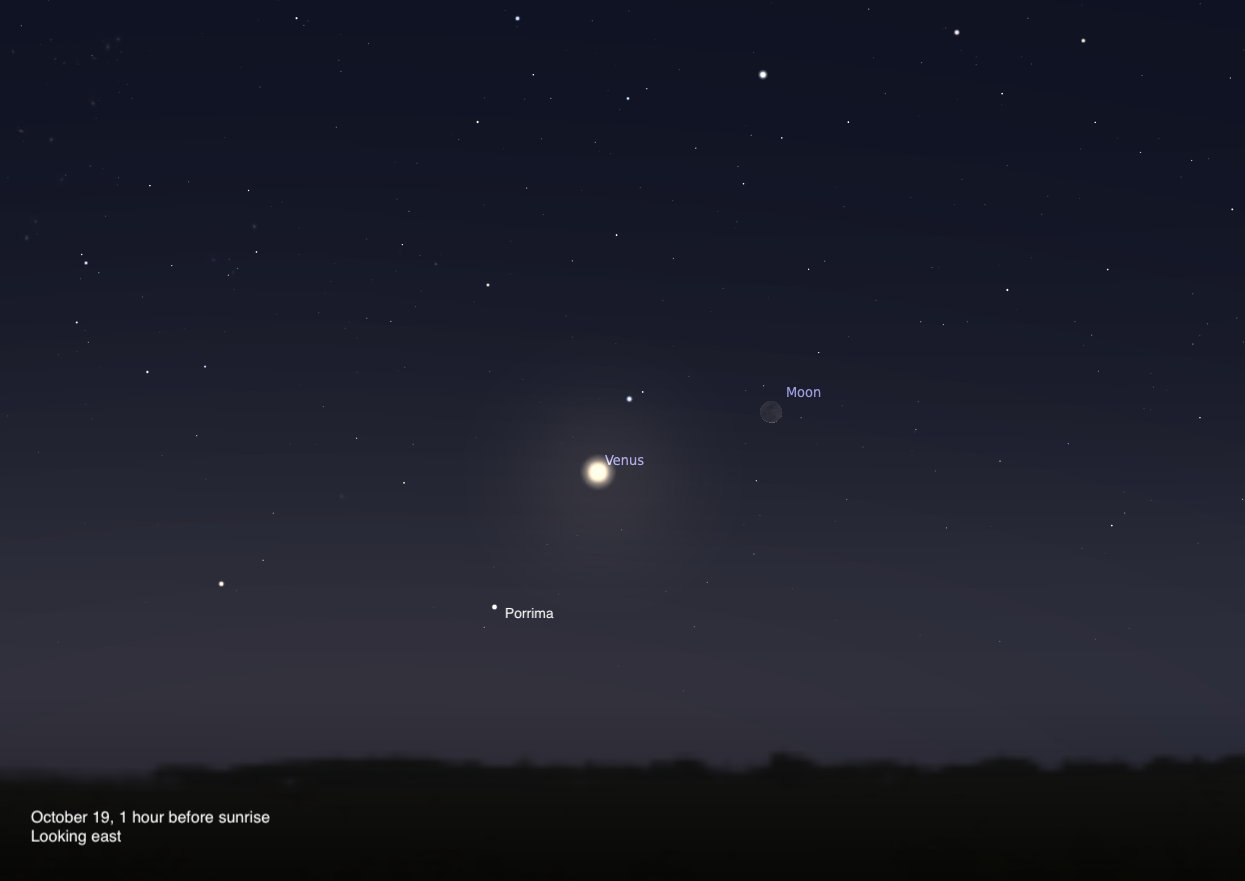Again to Article Listing
Jupiter’s two innermost Galilean moons cross in entrance of the planet, taking part in tag with their shadows this morning.
By 6 A.M. CDT, each Io and Europa’s shadows are seen on Jupiter’s cloud tops, because the moons themselves put together to transit. Callisto and Ganymede lie farther east (to the left on this view). Credit score: Stellarium/James Hastings-Trew/NASA Cassini
On October seventeenth, early morning observations of Jupiter will characteristic transits of Io’s and Europa’s shadows throughout its cloud tops, with particular timings various by time zone.
A telescopic view of Jupiter on this date will reveal all 4 Galilean moons strung out to its east.
The next morning will current a conjunction of the waning crescent Moon (4% illuminated) and Venus (94% illuminated, gibbous part) within the predawn sky inside the constellation Virgo.
Under this conjunction, the Third-magnitude double star Porrima (Gamma Virginis), with elements roughly 4” aside, might be observable by way of a telescope.
In search of a sky occasion this week? Take a look at our full Sky This Week column.
October 17: Catch open cluster M34
Jupiter stands excessive within the sky early this morning, ripe for viewing as two of its 4 Galilean moons chase their shadows throughout the cloud tops.
By 6 A.M. EDT, the fuel big stands almost 60° excessive within the southeast, beneath (and outshining) the 2 brilliant stars marking the heads of Gemini the Twins. Zoom in on the planet with a telescope to see all 4 Galilean moons strung out to the planet’s east. Io is closest to the planet; subsequent is Europa, then Callisto, with Ganymede farthest east.
Ensure you’re prepared about half an hour later, as Io’s shadow is first to seem on the southeastern limb at 6:36 A.M. EDT. Europa’s shadow seems six minutes later. Io reaches the limb and begins to transit at 6:52 A.M. CDT, as twilight is beginning to brighten skies throughout the Midwest. The western U.S. will be capable of watch as Callisto’s shadow seems on the southeastern limb at 6:07 A.M. PDT (notice the time change). Twelve minutes later, Europa begins its transit at 6:19 A.M. PDT, with Io lastly starting to method the southwestern limb.
Dawn: 7:14 A.M.Sundown: 6:15 P.M.Moonrise: 4:25 A.M. Moonset: 4:58 P.M.Moon Section: Waning crescent (5%)*Occasions for dawn, sundown, moonrise, and moonset are given in native time from 40° N 90° W. The Moon’s illumination is given at 10 P.M. native time from the identical location.
Tomorrow morning, The Moon and Venus dangle shut collectively within the predawn sky, sharing the sky within the constellation Virgo. An hour earlier than dawn, look east to identify Venus, the brightest level of sunshine, blazing at magnitude –3.9 almost 7° above the horizon and climbing. The fragile crescent Moon lies to its higher proper, simply 4° to the planet’s west.

Venus and the Moon rise earlier than the Solar this morning, seen within the constellation Virgo. The double star Porrima can also be obtainable for these with a clearer japanese horizon. Credit score: Stellarium/USGS/Celestia/Clementine
By way of a telescope, Venus seems 94 p.c lit, its gibbous part reverse the Moon’s skinny crescent part, with just some 4 p.c of our satellite tv for pc lit this morning. Venus’ disk stretches 11” on the sky, making its part readily seen within the eyepiece.
Under them would be the Third-magnitude star Porrima (Gamma Virginis), a well-known double star with elements about 4” aside, simple to separate in a telescope. They’re almost similar blue-white suns that shine at roughly the identical magnitude.


